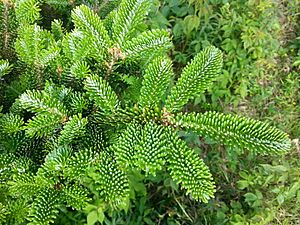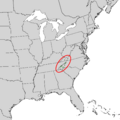Fraser fir facts for kids
Quick facts for kids Fraser fir |
|
|---|---|
 |
|
| Foliage and cone | |
| Conservation status | |
| Scientific classification | |
| Genus: |
Abies
|
| Species: |
fraseri
|
 |
|
| Natural range of Abies fraseri | |
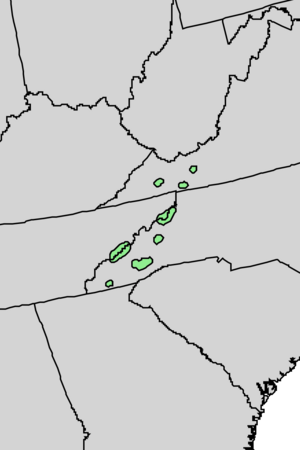 |
|
| Close-up of natural range of Abies fraseri | |
| Synonyms | |
|
|
The Fraser fir (Abies fraseri) is a type of fir tree. It grows naturally in the Appalachian Mountains in the southeastern United States.
This tree is very similar to the balsam fir. Sometimes, people even consider it a subspecies or variety of the balsam fir.
Contents
Names of the Fraser Fir
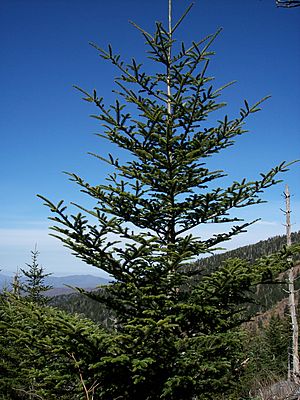
The Fraser fir is named after a Scottish botanist named John Fraser (1750–1811). He collected many plants in this region. Sometimes, people misspell its name as "Frasier," "Frazer," or "Frazier."
In the past, people also called it "she-balsam." This was because you could collect a sticky liquid (resin) from its bark. Another tree, the red spruce, was called "he balsam" because you couldn't get resin from it in the same way. The Fraser fir was also sometimes called "balsam fir," which could be confusing since that's the name of a different tree.
What the Fraser Fir Looks Like
The Fraser fir is a small evergreen conifer tree. This means it keeps its needles all year round and has cones. It usually grows about 30 to 50 feet (10–15 meters) tall. Sometimes, it can reach 80 feet (25 meters). Its trunk is usually 16 to 20 inches (40–50 cm) wide.
The tree has a cone shape. Its branches are either straight out or angled slightly upwards. When the tree is young, its branches are close together. As it gets older, they spread out more. The bark is thin and smooth. It's grayish-brown and has many sticky blisters when the tree is young. Older trees have bark that is cracked and scaly.
Fraser Fir Needles
The leaves are like needles. They are arranged in a spiral pattern on the branches. However, they twist at their bases to form two neat rows on each twig. Each needle is about 0.4 to 0.9 inches (10–23 mm) long. They are flat, flexible, and have rounded tips.
The top side of the needles is dark green. The underside has two silvery-white lines. These lines are made of tiny pores called stomata, which help the tree breathe. The needles have a strong smell, like turpentine.
Fraser Fir Cones
The cones stand upright on the branches. They are shaped like cylinders. They are usually 1.4 to 2.75 inches (3.5–7 cm) long and 1 to 1.2 inches (2.5–3 cm) wide. When they first appear, they are dark purple. As they get older, they turn pale brown.
The cones often have sticky resin on them. They also have long, bent-back scales that can be green, yellow, or light purple. When the cones are 4 to 6 months old, they break apart. This releases their winged seeds, which can then fly away and grow new trees.
Fraser Fir Ecology
Reproduction and Life Cycle
Fraser firs are "monoecious." This means that both male and female cones grow on the same tree. The cone buds usually open from mid-May to early June. Female cones grow mostly at the very top of the tree and at the ends of branches. Male cones grow below the female cones, but still in the upper part of the tree.
Fraser firs can start making seeds when they are about 15 years old. The seeds grow well in different places. They can sprout on mineral soil, moss, peat, old stumps, logs, or even on moist leaf litter.
Where Fraser Firs Grow
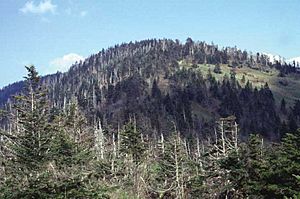
The Fraser fir only grows in the southeastern Appalachian Mountains. You can find it in southwestern Virginia, western North Carolina, and eastern Tennessee. It grows at high elevations, from about 3,900 feet up to the top of Mount Mitchell. Mount Mitchell is the highest point in the region, at 6,684 feet (2,037 meters).
These trees like soil that is acidic, moist, and drains well. They often grow mixed with red spruce trees. Other trees that grow with Fraser firs include Carolina hemlock, Yellow birch, paper birch, and sugar maple. The climate where they live is cool and moist. Summers are short and cool, and winters are cold with lots of snow.
Pests Affecting Fraser Firs
The Fraser fir has been badly damaged by an insect called the balsam woolly adelgid (Adelges piceae). This insect is not native to the area. When it arrived and spread, it caused a quick decline in Fraser firs. More than 80 percent of the older trees were killed.
However, many healthy young trees have grown back where the old forests once stood. This is because new seedlings can grow quickly when there is more sunlight. But when these young trees get older and their bark starts to crack, the adelgids might attack them again.
Because of this, the future of the Fraser fir is still uncertain. However, the trees in the Mount Rogers area of Virginia have mostly avoided being killed by the adelgid. The decline of the Fraser fir has also caused problems for other creatures, like the spruce-fir moss spider, which relies on the moss habitat found in these forests.
By the late 1990s, the number of adelgids had gone down. A study in the Great Smoky Mountains National Park showed good news. Even though two-thirds of adult trees were killed by the 1980s, the number of adult trees had increased over the next 30 years. There were three times as many trees on Clingmans Dome in 2020.
Threats to the Fraser Fir
The Fraser fir is considered an endangered species. The main threats to this tree are climate change and the balsam woolly adelgid insect.
How Fraser Firs Are Used
Fraser firs are not usually used for timber. However, they are very popular as Christmas trees. They have a nice cone shape, strong branches, soft needles that stay on for a long time, a dark blue-green color, and a pleasant smell. They also ship well.
The Fraser fir has been chosen as the White House Christmas tree more times than any other tree. Growing Christmas trees is a huge business in the southern Appalachian Mountains. North Carolina produces most of the Fraser fir Christmas trees. It takes about seven to ten years for a tree to grow to 6-7 feet (1.8-2.1 meters) tall. In 2005, North Carolina made the Fraser fir its official state Christmas tree.
Fraser firs are also grown from seedlings in other northern U.S. states and in Quebec, Canada, specifically for the Christmas tree market. They are also grown on tree farms in Scotland and sold throughout the United Kingdom and Ireland.
Images for kids
See also
 In Spanish: Abies fraseri para niños
In Spanish: Abies fraseri para niños



